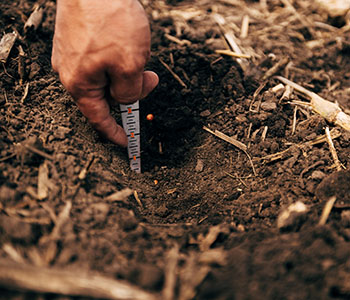Laying the Groundwork for Planting
Feb 01, 2024

Mike Tufte
Seed Specialist
It’s hard to believe that we are already over a month into the new year! January brought us some unusual weather. In a single week, some areas had over 20 inches of snow and other areas received more snow than they did all last winter. Some areas even broke the January snowfall record! Then came the frigid cold temperatures, with days when the diesel pumps did not want to cooperate.
Fast forward and we had a nice, solid week of fog and rain. That took care of a good portion of the snow, and now (as I write this) we are looking at some warmer than usual temps. As I look around, I’m not seeing many ditches full of water. That tells me that the moisture we received is being absorbed into the ground. Although snow doesn’t give us much, it all helps at this point. We don’t know what spring will bring us, but we know one thing for sure: we will be planting a crop in 2024. So, let’s talk a little about planting.
Imbibitional Chilling Injury
As you’ve heard me say before, plants are living organisms. There are a thousand variables that can make or break a great crop. Unfortunately, Mother Nature oversees most of those variables. But what about the variables that we can control? First and foremost is your seed bed. Corn requires a minimum of 50 degrees Fahrenheit to germinate, and roughly 100 growing degree units to emerge. If we don’t have warm enough soil, we risk a lot of things, such as imbibitional chilling injury.
Imbibitional chilling injury occurs when corn seed takes on cold moisture such as rain or melting snow, right after planting. The corn cell membrane can become rugged and burst. When this happens, the seed dies, and will no longer germinate. This reduces stand. Most of us have some rather dry soil right now. This is important because dry soils experience more fluctuations in temperature, so we must pay attention to nighttime temps. We want to make sure our lowest temps of the day do not dip below that 50-degree mark for any extended period of time.
Planting Depth
Our next variable is planting depth and speed. The old school of thought was that all corn must be planted at a depth of two inches. That has now changed a bit to accommodate soil moisture. We typically still like to see corn planted at two inches, however, if we are in dry conditions, we can go to two and a half inches. Some may even go as deep as three inches to find soil moisture. Keep in mind that planting too deep can cause uneven emergence. I still think too deep is better than too shallow, within reason, of course. If you are running trash whippers, the soil will likely settle a bit after planting and reduce the depth of that seed from the surface.
When it comes to planter speed, slow and steady wins the race. I know we have new technology that allows for faster planting, but I’m still a fan of the singulation at four to five mph. It’s a rather unpopular opinion in 2024, but try one field and see what difference it makes.
Seed Selection
Finally, I’d like to talk about seed selection. There are a lot of options out there, and it can be tough to navigate. Having the right seed on the right acre is just as important as the rest of this article. Seed companies bring us new hybrids every year. Some are hybrids that have a very broad acre fit. Other hybrids have a niche area that they work well in.
Nobody knows the local acres and the hybrids that fit those acres better than the agronomists at Key Cooperative. For this reason, I am introducing a new “Hybrid of the Month” series. Each month in our newsletter, we will showcase an agronomist and the hybrid they select for their area. This hybrid is one that they feel works best in their geography. They will give you an in-depth explanation of its strengths and weaknesses.
Throughout the course of the year, you’ll be able to follow along and determine which hybrids are for you. Some hybrids may come from another area, but also fit your acres. If you have questions regarding a particular hybrid and its potential fit, feel free to contact your local Key Cooperative agronomist, or myself. We would love the opportunity to sit down and help place the right product on your acres!